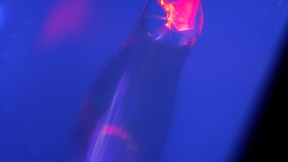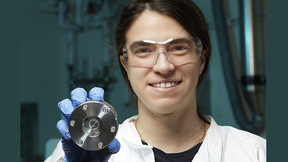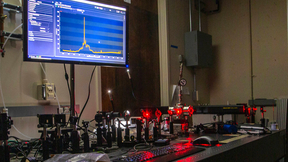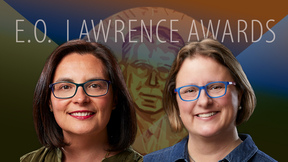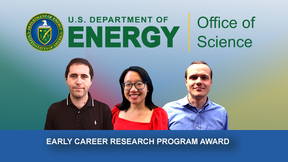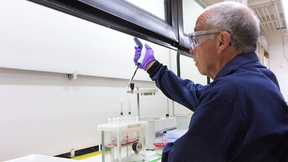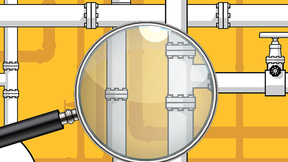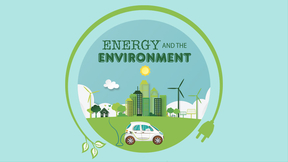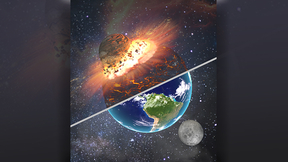Back
Of the four forces, the weak nuclear force is the least understood and most difficult to detect. A Lawrence Livermore team headed by physicist Nick Scielzo partnered with scientists from Argonne National Laboratory, Louisiana State University, and other universities to better characterize the weak force’s foundations. Thanks to significant advances in experimental design…
It could be called better understanding through chemistry. An international research team including Lawrence Livermore National Laboratory (LLNL) scientists has succeeded in gaining new insights into the chemical properties of the superheavy element flerovium — element 114. The measurements, taken at the at the accelerator facilities of the GSI Helmholtzzentrum für…
An international team including a researcher from Lawrence Livermore National Laboratory (LLNL) has determined that one specific particle on the asteroid Ryugu can shed light on the unaltered initial materials from its parent body. In December 2014, the Japanese Aerospace Exploration Agency launched the spacecraft Hayabusa2 to the asteroid 162173 Ryugu. In December 2020,…
The synthesis and study of radioactive compounds are naturally difficult due to the extreme toxicity of the materials involved, but also because of the cost and scarcity of research isotopes. Now, Lawrence Livermore National Laboratory (LLNL) scientists and their collaborators at Oregon State University (OSU) have developed a new method to isolate and study in great detail…
No need to worry, it is just a very small piece for scientific study. In December 2014, the Japanese Aerospace Exploration Agency launched the spacecraft Hayabusa2 to the asteroid 162173 Ryugu. In December 2020, when the sample-return capsule successfully landed safely back on Earth with pristine pieces of Ryugu that it had collected, Lawrence Livermore National Laboratory…
Lawrence Livermore National Laboratory (LLNL) intern Jordan Stanberry is spending his summer examining pond sediments to better understand groundwater contamination from decades-old nuclear tests. A chemistry graduate student from the University of Central Florida (UCF), Stanberry is participating in an eight-week Glenn T. Seaborg Institute (GTSI) internship program. The…
This week, President Biden signed into law the bipartisan bill known as the CHIPS and Science Act (CSC ACT). The bill aims to strengthen U.S. competition by encouraging U.S. companies to manufacture semiconductors and by revitalizing “America’s scientific research and technological leadership." Under Title V: Broadening Participation in Science of the bill, the White House…
Soil is the largest terrestrial reservoir of organic carbon and is central for climate change mitigation and adaptation. Mineral-organic associations play a critical role in soil carbon preservation, but the global capacity for storage in this form has never been quantified. New research from Lawrence Livermore National Laboratory (LLNL) and an international team of…
A team of researchers from Lawrence Livermore National Laboratory (LLNL) and the University of Michigan has found that the rate of cooling in reactions dramatically affects the type of uranium molecules that form. The team’s experimental work, conducted over about a year-and-a-half starting in October 2020, attempts to help understand what uranium compounds might form in…
For the first time, scientists have shown that glaciers in the tropical Andes mountains have been in sync with polar ice extent in Antarctica and the Arctic for nearly a million years. New research by an international team, including Lawrence Livermore National Laboratory (LLNL) scientist Christine Y. Chen, records glacier movement in the Southern Hemisphere that dates…
Deep below the Black Hills of South Dakota in the Sanford Underground Research Facility (SURF), an innovative and uniquely sensitive dark matter detector — the LUX-ZEPLIN (LZ) experiment, led by Lawrence Berkeley National Lab (Berkeley Lab) — has passed a check-out phase of startup operations and delivered its first results. In a paper posted online today on the experiment…
Two Lawrence Livermore National Laboratory (LLNL) scientists are recipients of the prestigious 2021 E.O. Lawrence Award that recognizes mid-career U.S. scientists and engineers for exceptional scientific, technical and engineering achievements related to the broad missions of the Department of Energy (DOE) and its programs. Jennifer Pett-Ridge was recognized for her…
Three scientists from Lawrence Livermore National Laboratory (LLNL) are recipients of the Department of Energy’s (DOE) Office of Science Early Career Research Program award. Mimi Yung, John Despotopulos and Timofey Frolov are among 83 awardees receiving the recognition. Under the program, typical awards for DOE national laboratory staff are $500,000 per year for five years…
Lawrence Livermore National Laboratory (LLNL) scientists and collaborators have used a new technique to better forecast the level of algal toxins that accumulate in Lake Erie every year. Harmful algal blooms (HABs) are global phenomena and, in freshwater lakes and reservoirs, are caused by cyanobacteria of the genus Microcystis that produce microcystins, a suite of amino…
Advancing superheavy-element chemistry—the study of elements with an atomic number greater than 103—is a challenging task because of their scarce production rates and relatively short half-lives (i.e., less than 1 minute for most), thus requiring studies to be performed at the atom-at-a-time scale. The properties of these elements are linked to the physics and chemistry at…
Even after taking highly stressful exams in college, grades can still be important. Just ask researchers at Lawrence Livermore National Laboratory’s (LLNL) Forensic Science Center (FSC). Every fall, chemists and other researchers from the FSC spend two weeks of long days undertaking the Organisation for the Prohibition of Chemical Weapons (OPCW) environmental proficiency…
As with most mysteries, this one starts with a puzzling scene: a waterlogged field situated near Lawrence Livermore and Sandia national laboratories in Livermore, California. The property belongs to Wente Vineyards, a winery in the region, whose establishment predates the Laboratory by nearly 100 years. How the water got there and why was unclear, but the most likely…
Throughout the month of February, scientists from the Physical and Life Sciences (PLS) directorate virtually participated in three of the four 2022 Science on Saturday (SOS) lectures, presenting on the theme “Energy and the Environment.” The SOS lecture series is an annual collaboration between scientists at Lawrence Livermore National Laboratory (LLNL) and staff members…
Whether dead or alive, soil microorganisms play a major role in the biogeochemical cycling of carbon in the terrestrial biosphere. But what is the specific role of death for the bacteria, fungi and microfauna that make up the soil microbiome? That is the topic of a new review by Lawrence Livermore National Laboratory (LLNL) scientists and collaborators. The article,…
Earth’s supply of water is incredibly important for its ability to sustain life, but where did that water come from? Was it present when Earth formed or was it delivered later by meteorites or comets from outer space? The source of Earth’s water has been a longstanding debate and Lawrence Livermore National Laboratory (LLNL) scientists think they have the answer — and they…




